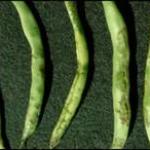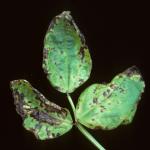Bean, Halo Blight
Pseudomonas syringae pv. phaseolicola
Halo blight caused by Pseudomonas syringae pv. phaseolicola is a major disease of beans throughout the world. The pathogen attacks both foliage and pods. The disease is most destructive where temperatures are moderate and abundant inoculum is available.
Identification:
Leaf symptoms first appear as small, water-soaked spots on the lower leaf surface. These lesions rapidly become necrotic and are visible on both upper and lower leaf surfaces. Infection of expanding leaves may result in leaf distortion. A chlorotic zone of yellow tissue (halo) develops around necrotic spots. In cases of severe infection, a generalized systemic chlorosis can occur. Symptoms also occur on pods and stems as water-soaked, red or brown lesions which may exhibit crusty bacterial ooze.
Life Cycle:
Sources of P.s. pv phaseolicola are contaminated seed and infected crop residue. Seedlings originating from contaminated seed harbor large numbers of bacteria. Bacteria from infected plant debris are spread by splashing water and blowing soil. The bacteria enter the plant through natural openings or wounds during periods of high relative humidity or free moisture. At cool temperatures, the pathogen produces a toxin, phaseolotoxin, which is responsible for systemic chlorosis. After 7-10 days, bacteria ooze from lesions imparting a greasy appearance. Secondary infections develop from these bacteria. Halo blight is considered to be a cool temperature disease and frequently occurs shortly after seedling emergence if environmental conditions are conducive.
Crop Injury:
Foliage infections by Halo Blight result in reductions in plant stand and productivity. Pod infections reduce marketability of snap beans and seed production of dry beans. Severe infections can result in total crop loss.
Cultural Controls & Prevention:
- Start with certified, disease free seed. Seed produced in arid areas and tested for freedom from Halo blight should be used.
- Cultivars with resistance are available.
- Rotate to non-host crops for 2-4 years.
- Promptly incorporate bean debris after harvest to encourage decomposition.
- Eliminate weeds and volunteer beans that might be potential reservoirs for the bacteria.
- Furrow or drip irrigation is preferred to prevent secondary spread of the bacteria.
- Avoid cultivation and other traffic through fields when the foliage is wet.
Chemical Controls & Pesticides:
For Current information on disease recommendations ins specific crops including information on chemical control & pesticide management, please visit the New England Vegetable Management Guide website.
Crops that are affected by this disease:
The Center for Agriculture, Food and the Environment and UMass Extension are equal opportunity providers and employers, United States Department of Agriculture cooperating. Contact your local Extension office for information on disability accommodations. Contact the State Center Director’s Office if you have concerns related to discrimination, 413-545-4800 or see ag.umass.edu/civil-rights-information.


